May 30, 2014
Inspector General: EPA could be relying on fraudulent data
By: Lachlan Markay
As the Environmental Protection Agency prepares major new regulations on carbon emissions, the agency’s top watchdog is warning that fraudulent environmental data may be influencing its work.
The findings could provide fodder for critics of the new regulation, who warn that it could cost the U.S. economy billions and cause hundreds of thousands of Americans to lose their jobs.
“The EPA lacks a due diligence process for potential fraudulent environmental data,” the agency’s inspector general warned in a report released on Thursday. Existing processes for weeding out such data, the report said, are “out of date or unimplemented.”
“Our survey of EPA regional staff on their knowledge and use of the EPA’s fraudulent data policies and procedures found that a majority of respondents were unaware there was a policy, and approximately 50 percent expressed the need for such policies and procedures,” the report said.
The EPA relies in large measure on federal contractors to gather environmental data on which the agency bases its regulatory decisions. However, a lack of communication with those contractors and clear guidelines on investigative procedures has created confusion with respect to the processes by which fraudulent data is rooted out and corrected.
Similar problems plague interactions between EPA and state environmental regulators, the report found.
“The agency lacks policy on communicating case information with the states and other regulating parties during investigations,” the IG wrote. As a result, “potentially negative consequences for human health and environmental protection may be not be communicated or addressed.”
The EPA said it would initiate a number of corrective actions to remedy the problems. The IG was satisfied with the actions, saying “recommendations are considered resolved and open with corrective actions ongoing.”
Without those corrective actions, the report warned, the agency risks undermining public confidence in its regulatory work.
A lack of public confidence could be troublesome for the agency as it rolls out new regulations on existing coal-fired power plants that are sure to stoke controversy in Washington and around the country.
Aimed at reducing what the administration calls “carbon pollution,” the regulations could reduce U.S. gross domestic product by $51 billion and cause average job losses in excess of 200,000 every year through 2030, according to a study released this week.
“These carbon rules are another example of Washington bureaucrats picking energy winners and losers,” said Sean Hackbarth, a spokesman for the Chamber of Commerce, which commissioned the study. “The biggest losers will be Americans who lose their jobs and feel the brunt of higher electricity costs.”
------
It should be noted, the Environmental Protection Agency’s Inspector General had found that the agency based its 2009 “Endangerment Finding” on a flawed and inadequate assessment of climate science.
Thought the report challenged the EPA’s justification for its decision to regulate greenhouse gas emissions using the Clean Air Act relied on politically-biased science that did not meet minimal federal Information Quality Act requirements for objectivity, the DC Circuit Court refused to allow lawyers to submit the IG report to the court for their evaluation of the EPA’s right to proceed with regulatory assault on moving and later stationary sources of CO2.
Not only has our administrative and legislative branches failed us but our legal system has stopped being the check and balance the founding fathers expected they would be.
May 15, 2014
NCDC doctors data AGAIN and Big Green’s untold billions
Ron Arnold
NCDC USHCN in 1999 showed a nice sine wave in temperatures from 1895 to 1999 but no warming trend if you looked at peak to peak. The data was regarded as the best in the world with relatively stable stations (though as Anthony Watts showed increasingly poorly sited) and with adjustments for urbanization developed by NCDC chief Tom Karl, which offset some of this local contamination. Hansen in 1999 said after the super El Nino of 1997/98 (which was 1.1F cooler than 1934 that there was a lot of year to year variability but little long term trend with the 1930s clearly the warmest decade and 1934 the warmest year. Hansen posted a note on GISS that the US was only 1.6% of the world and local variances are always possible (even though it was known as GLOBAL warming).
This produced a dilemma for the modelers and policy makers as the global data set which unlike the US had no UHI adjustment because NCDC did not have the metadata (precise local siting info) to use the same adjustment. NCDC was pressured to make the US data consistent - and so in 2008 they removed the urbanization adjustment and substituted a new algorithm to ‘detect previously undisclosed inhomegeneities’ (station moves for example). Although this new algorithm might catch a few stations where moves had not been documented, the removal of the UHI adjustment and a final new step called homogenization resulted in a significant change so that 1998 suddenly went from 1.1F colder than 1934 to almost 0.0 to 0.1F warmer than 1934.
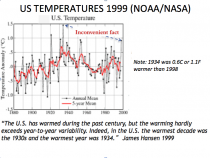
Enlarged
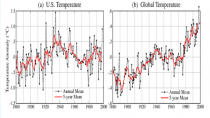
Enlarged
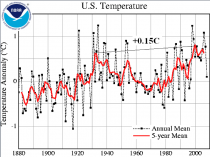
Enlarged
The change was about 1.3F with early cooling and late warming.
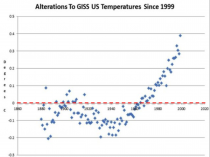
Enlarged
There have been a few more iterations for the US and global data - each increasing the computed warming. This March after a very cold winter had NCDC sweating, a new version of the US state data displayed at Climate at a glance took place.
See an example of what they did for one state - Maine. In 2012, I downloaded the annual data and it showed little change over time. In fact as of 2013, the NCDC Maine data showed a 0.03F/decade cooling since 1895.
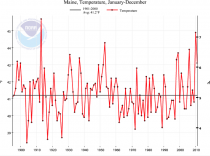
Enlarged
After March, the new state data showed a 0.23./decade warming with a cooling of the early 1900s by up to 5F.
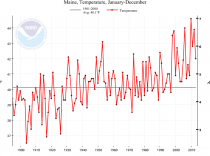
Enlarged
-------
Big Green’s Untold Billions
Ron Arnold
The ‘Kill Keystone XL’ crowd isn’t little David up against a Big Oil Goliath. As usual, conventional wisdom isn’t wisdom when the mainstream media ask all the wrong questions with commensurate answers.
Behemoth Big Green outstrips Big Oil in expendable revenue by orders of magnitude - if you know how to follow the money.
The mainstream media don’t know how. Like most liberals, their staffs are afflicted with what 20th century futurist Herman Kahn called “Educated Incapacity” - the learned inability to understand or even perceive a problem, much less a solution.
They’ve been taught to be blind, unable to see Big Green as having more disposable money than Big Oil, so they don’t look into it.
They would never discover that the American Petroleum Institute’s IRS Form 990 for the most recent year showed $237.9 million in assets while the Natural Resources Defense Council reported $241.8 million.
Nor would they discover who started the anti-Keystone campaign in the first place. It was the $789 million Rockefeller Brothers Fund (established in 1940). The fund’s program is elaborated in a 2008 PowerPoint presentation called “The Tar Sands Campaign” by program officer Michael Northrop, who set up coordination and funding for a dozen environmental and anti-corporate attack groups to use the strategy, “raise the negatives, raise the costs, slow down and stop infrastructure, and stop pipelines.” Tom Steyer’s $100 million solo act is naive underclass nouveau cheap by comparison.
Mainstream reporters appear not to be aware of the component parts that comprise Big Green: environmentalist membership groups, nonprofit law firms, nonprofit real estate trusts (The Nature Conservancy alone holds $6 billion in assets), wealthy foundations giving prescriptive grants, and agenda-making cartels such as the 200-plus member Environmental Grantmakers Association. They each play a major socio-political role.
Invisible fact: the environmental movement is a mature, highly developed network with top leadership stewarding a vast institutional memory, a fiercely loyal cadre of competent social and political operatives, and millions of high-demographic members ready to be mobilized as needed.
That membership base is a built-in free public relations machine responsive to the push of a social media button sending politically powerful “educational” alerts that don’t show up on election reports.
Big Oil doesn’t have that, but has to pay for lobbyists, public relations firms and support groups that do show up on reports.
You don’t need expert skills to connect the dots linking Keystone XL to Alberta’s oil sands to climate change to Big Green.
On the other hand, you do need detailed knowledge to parse Big Green into its constituent parts. I spoke with CFACT senior policy analyst Paul Driessen, who said, “U.S. environmental activist groups are a $13-billion-a-year industry - and they’re all about PR and mobilizing the troops.
“Their climate change campaign alone has well over a billion dollars annually, and high-profile battles against drilling, fracking, oil sands and Keystone get a big chunk of that, as demonstrated by the Rockefeller assault.”
Driessen then identified the most-neglected of all money sources in Big Green: “The liberal foundations that give targeted grants to Big Green operations have well over $100 billion at their disposal.”
That figure is confirmed in the Foundation Center database of the Top 100 Foundations. But how much actually gets to environmental groups? The Giving USA Institute’s annual reports show $80,427,810,000 (more than $80 billion) in giving to environmental recipients from 2000 to 2012.
I checked the U.S. Chamber of Commerce and found $147.3 million in assets while environmental donor Gordon E. and Betty I. Moore Foundation posted $5.2 billion.
Driessen pointed out another unperceived sector of Big Green: government donors. “Under President Obama, government agencies have poured tens of millions into nonprofit groups for anti-hydrocarbon campaigns.”
Weather Channel co-founder John Coleman adds, “The federal government is currently spending $2.6 billion [per year] on climate change research (and only those who support the “carbon dioxide is a pollutant/major greenhouse gas” receive funding).”
This web of ideological soul-mates, like all movements, has its share of turf wars and dissension in the ranks, but, as disclosed on conference tapes I obtained, it shares a visceral hatred of capitalism, a worshipful trust that nature knows best, and a callous belief that humans are not natural but the nemesis of all that is natural.
Lawyer Christopher Manes wrote “Green Rage: Radical Environmentalism and the Unmaking of Civilization.” Manes now practices tax litigation from his law office in Palm Springs, Calif., which he has not yet unmade.
The legal branch of Big Green is varied. Earthjustice, (formerly Sierra Club Legal Defense Fund) raked in $133.8 million in the past five years - comparable to many similar law organizations. Highly litigative attack groups receiving federal settlements are numerous and thriving, such as the Center for Biological Diversity ($29.2 million in the past five years).
It’s not unusual for heirs of big money to dream of unmaking the source of their wealth: Laura Rockefeller Chasin of the Rockefeller Family Fund once said, “It’s very hard to get rid of the money is a way that does more good than harm. One of the ways is to subsidize people who are trying to change the system and get rid of people like us.”
The money reported to the Federal Election Commission is barely the beginning of what’s really happening. It doesn’t show you Big Green’s mobilized boots on the ground, the zooming Twitter tweets, the fevered protesters, the Facebook fanatics or the celebrities preaching carbon modesty from the lounges of their private jets.
When self-righteous victims of Educated Incapacity insist that Big Oil outspends the poor little greenies, keep in mind the mountains of IRS Form 990s filed by thousands of groups, land trusts, lawyer outfits, foundations, and agenda-makers, just waiting for America to wake up and smell Big Green’s untold hundreds of billions.
See more here.
May 13, 2014
The amount of nonsense in public debate on extreme events and climate change remains at a high level
Roger Pielke Jr.

The amount of nonsense in public debate on extreme events and climate change remains at a high level. This is great news for me because it provides plenty of opportunities to discuss what the actual science says and how we think we know what we know. As I have long argued, accurate representations of the state of science of extremes is far more important as a matter of scientific integrity than to the hyper-politiczed debate over climate change. Put another way, it is highly unlikely that misrepresentations of the state of science will do much to move action on energy policies, but they could damage the integrity of leading institutions of science.
This is a short post about drought, which simply summarizes the bottom-line conclusions of two of the most recent major scientific assessments of extreme events and climate change, one by the US government, released in 2008 under the Bush administration (PDF, and then reaffirmed in the CCSP Unified Synthesis under the Obama Administration, here) and the second from the IPCC.
First, from the US government’s assessment of extreme events in the US, here is what it concluded about drought (here in PDF, at p. 42):
The most widespread and severe drought conditions occurred in the 1930s and 1950s (Andreadis et al., 2005). The early 2000s were also characterized by severe droughts in some areas, notably in the western United States. When averaged across the entire United States (Figure 2.6), there is no clear tendency for a trend based on the PDSI. Similarly, long-term trends (1925-2003) of hydrologic droughts based on model derived soil moisture and runoff show that droughts have, for the most part, become shorter, less frequent, and cover a smaller portion of the U. S. over the last century (Andreadis and Lettenmaier, 2006). The main exception is the Southwest and parts of the interior of the West, where increased temperature has led to rising drought trends (Groisman et al., 2004; Andreadis and Lettenmaier, 2006). The trends averaged over all of North America since 1950 (Figure 2.6) are similar to U.S. trends for the same period, indicating no overall trend.
Got that? Over the climate time scales “droughts have, for the most part, become shorter, less frequent, and cover a smaller portion of the U. S. over the last century.” At the top of this post is Figure 2.6 from that report, showing drought incidence in the US (red) and North America (blue) from 1900.
The IPCC in 2012 conducted a survey of drought globally, and concluded with the following (here in PDF, at p. 171):
There is not enough evidence at present to suggest high confidence in observed trends in dryness due to lack of direct observations, some geographical inconsistencies in the trends, and some dependencies of inferred trends on the index choice. There is medium confidence that since the 1950s some regions of the world have experienced more intense and longer droughts (e.g., southern Europe, west Africa) but also opposite trends exist in other regions (e.g., central North America, northwestern Australia).
Got that? Some places have become dryer, others wetter, and not much confidence in asserting the presence of any trends at the global scale.
Now it is of course true that the recent assessments of the US government and IPCC are not the last words on these subjects. They represents attempts by governments to have scientists systematically arbitrate questions that can resolved empirically, such as “has drought increased or decreased?”
Anyone who shows up in public debate (or the scientific literature) with an alternative view (e.g., droughts have become worse in the US or there is more certainty at the global level) had better come with some strong evidence. The need for strong evidence comes not simply from the authority of these assessments, but because they represent a condensation of a large amount of literature. To overturn the conventional wisdom expressed in the assessments requires overturning the arguments found in the literature on which the assessment is based. The same logic goes for people who would challenge other findings from such assessments, such as in making a claim that the globe is not warming.
The findings of assessments are not however received truth. As we have seen, those leading and participating in such assessments can err egregiously—where an error means a failure to accurately reflect in the assessment the underlying scientific literature. Here overturning the assessment is relatively easy, as it does not require over turning the literature, but simply representing it accurately. This is why the IPCC SREX came to different conclusions on extremes than did AR4.
Unfortunately, there are no shortcuts here to reliable knowledge - just because the IPCC erred on one subject does not mean that it necessarily erred on others. Each knowledge claim must be evaluated on its merits. Shortfalls in an assessment process may cause you (or me) to lose confidence in the integrity of that process, but it does not eliminate the need to evaluate knowledge claims on their merits using the methods of science.
The good news is that for extreme events and climate change there is a well-developed scientific literature on this topic, and it does not always jibe with what you might read in the news or hear from experts. Given the politicization of the climate debate, and the penetration of that politicization into academia, I don’t expect this to change anytime soon, if ever.
May 08, 2014
Joe Bastardi on NCA and John Coleman on ‘600 page litany of doom’
Joe Bastardi on the NCA.
---------
‘600 page litany of doom’
Weather Channel Co-Founder John Coleman slams Federal climate report: A ‘total distortion of the data and agenda driven, destructive episode of bad science gone berserk’
Coleman: ‘When the temperature data could no longer be bent to support global warming, they switched to climate change and now blame every weather and climate event on CO2 despite the hard, cold fact that the “radiative forcing” theory they built their claims on has totally failed to verify.’
‘The current bad science is all based on a theory that the increase in the amount of carbon dioxide in the atmosphere from the exhaust of the burning of fossil fuels leads to a dramatic increase in “the greenhouse effect” causing temperatures to skyrocket uncontrollably. This theory has failed to verify and is obviously dead wrong. But the politically funded and agenda driven scientists who have built their careers on this theory and live well on the 2.6 billion dollars of year of Federal grants for global warming/climate change research cling to this theory and bend the data spread to support the glorified claims in their reports and papers.’
John Coleman’s Blog for Wednesday, May 7th
The sky is falling. “Climate Change” is running wild and disaster is certain unless we immediately stop burning coal and oil and move quickly to “green energy” to eliminate use of fossil fuels. Heat waves, huge floods, powerful storms, droughts and rising seas are on the verge of killing millions of us and destroying our civilization. That is my summary of the new Federal Assessment of Climate Change issued by a Obama administration team of more than 300 specialists guided by a 60-member federal advisory committee produced the report. It was reviewed by federal agencies and a panel of the National Academy of Sciences.
This 600 page litany of doom and gloom has received extensive coverage by the panting anchors of the national media who feel important when tell their audience that “the sky is falling.” Horrible pictures of storms, floods, drought and heat waves leaped out of the TV sets as the New York and Washington DC headquartered media was particularly excited to tell us how the huge increases in floods and storms was the worst in that part of the nation.
If you accept the picture painted by this report, the weather was just right, steady and nice in the historic past but because our industrialized society has powered its heating and air conditioning, its transportation by train, plane, cars and trucks, generated it’s electric power to run our lights, computers, television and smart phones with fossil fuels it has triggered this nightmare of awful storms, droughts and heat waves.
I am deeply disturbed to have to suffer through this total distortion of the data and agenda driven, destructive episode of bad science gone berserk. The only good news is that I least where I am and on the channels and websites I saw I was not further insulted by fawning TV Weathercasters visiting the White House and interviewing the President. I best I can tell, on a national level, that turned out to be a non-event (thank goodness).
Please allow me to hold your attention for a few minutes to explain why I don’t buy into this Climate Change alarmism. The climate of Earth has never been “normal” or stable. It has continuously changed through this planet’s 4.5 billion year history. Powerful storms, floods, droughts, heat waves and ice and snow storms have come and gone as long as Earth has existed.
The current bad science is all based on a theory that the increase in the amount of carbon dioxide in the atmosphere from the exhaust of the burning of fossil fuels leads to a dramatic increase in “the greenhouse effect” causing temperatures to skyrocket uncontrollably. This theory has failed to verify and is obviously dead wrong. But the politically funded and agenda driven scientists who have built their careers on this theory and live well on the 2.6 billion dollars of year of Federal grants for global warming/climate change research cling to this theory and bend the data spread to support the glorified claims in their reports and papers.
When the temperature data could no longer be bent to support global warming, they switched to climate change and now blame every weather and climate event on CO2 despite the hard, cold fact that the “radiative forcing” theory they built their claims on has totally failed to verify.
They call people such as me who debunk their non-scientific silliness as “deniers” and claim we are flat-earthers and shills for “big oil”. It is insulting and maddening. But I will not be silenced. And neither will the thousand others, many of them with Ph.D.’s and on the faculties of major universities who are working to stop this bad science that labels CO2 as a pollutant and blames it for every shift in the weather.
We will be gathering, we global warming skeptics, at Heartland Institutes 9th International Conference on Climate Change, July 7 - 9, 2014 in Las Vegas. You can learn about that conference at http://climateconference.heartland.org/. I will be one of the speakers at the breakfast session on Tuesday July 8th. Look at the list of speakers on the website and you will see an impressive group.
A group of the powerful Ph.D.’s in the group have recently published a complete scientific document that totaling destroys the climate change alarmism of the US Democrat Party and the United Nation’s Intergovernmental Panel on Climate Change. You can find that publication on line at http://climatechangereconsidered.org/.
In the meantime, through blogs, and radio and television interviews whenever any of us can get on the air we will continue to try to debunk this way of climate alarmism. For instance, I will be on the air on WLS Radio in Chicago with Bruce Wolf & Dan Proft on Wednesday morning (today) at 8:45 AM Chicago time (6:45 AM San Diego time) and do my best to tell the real story of climate and weather. You can listen to that broadcast on line here.
All of this not withstanding, my life is sooo good. Every day is fun and relaxed since I have ended the tread mill life of grinding out all those TV weathercasts a day. I now do my dancing for fun only. LOL
May 06, 2014
Climate Change Mass Hysteria Grips the U.S.
Dr. Roy Spencer
WASHINGTON (AP) In what many experts are calling one of the most serious cases of mass hysteria in modern times, the U.S. government today released its National Climate Assessment, a sobering 840 page summary of a wide variety of normal climate occurrences which are leading to physical symptoms such as adolescent psychiatric problems, great wailing, and gnashing of teeth.

The report is gripping the nation like a global warming polar vortex trapped in place by the swirling toxic vapors emitted by a swarm of possessed SUVs.
The report contains claims of U.S. floods, droughts, severe weather, and heat waves, all of which are not unprecedented compared to centuries past, but are nevertheless known to be the fault of humans.
Ronald Wobbles, the report’s lead author, was quoted as saying (I am not making this up), “We’re already seeing extreme weather and it’s happening now”. This finding stands in stark contrast to 100 years ago, when ‘we saw extreme weather that was happening then’.
Climate deniers, known to be the same paid shills who once worked for the tobacco industry, were quick to pounce on the report’s findings, claiming that there is no evidence supporting either the view that U.S. climate has gotten worse, or that Elvis Presley had finally returned to Earth with a great new diet plan.
The report received a warm welcome from many politicians, lobbyists, government-funded scientists, insurance companies, media personalities, and Hollywood. “I can even see climate change in my back yard!” was a common refrain voiced by astute observers, presumably relying upon many decades of precise temperature measurements capturing the fraction of a degree temperature rise around their back patio on a NIST-calibrated Wal Mart thermometer.
Experts familiar with the mass hysteria outbreak have little hope that an antidote would be forthcoming any time soon. Said one psychologist who declined to be identified, “All we can hope is that the hysteria will run its course in the next several years as higher energy prices, brownouts, and blackouts set in.”
------
Roger Cohen adds:
“This is pure hogwash, of course, and that is being kind. The agent that is harming the economy is the US central government with its excessive regulations, its policies of failed excessive spending for no purpose other than to reward its constituencies, its fetish with class warfare and taxation, and its failure to permit federal lands to be accessed for its abundant resources.
As for its claims of more extreme weather, they are pure fabrication. The central government has reached the point where it expects us to believe that every storm, drought, flood, or whatever is due to driving your SUV. Like astrology their so called “science” is made to fit everything that happens after the fact, but they predict nothing that actually happens. Indeed the world has not warmed at all for more than 15 years, despite their predictions that it would. For those who want to see the real facts, consult for example the Congressional testimony of Dr. John Christy, Distinguished Professor of Atmospheric Science, Alabama’s State Climatologist and Director of the Earth System Science Center at The University of Alabama in Huntsville.
----------

The real deniers and dangerous characters are the authors of the report, the mainstream media that treats it most the words carried down on the tablets by Moses, and the administration which have led the politicization of science through billions in funding. You don’t need to read the science fiction that they are promoting. These three videos summarize it quite well.
----------
What the National Climate Assessment Doesn’t Tell You
By PAUL C. “CHIP” KNAPPENBERGER and PATRICK J. MICHAELS
Global Science Report is a feature from the Center for the Study of Science, where we highlight one or two important new items in the scientific literature or the popular media. For broader and more technical perspectives, consult our monthly “Current Wisdom.”
The Obama Administration this week is set to release the latest version of the National Climate Assessment, a report which is supposed to detail the potential impacts that climate change will have on the United States. The report overly focuses on the supposed negative impacts from climate change while largely dismissing or ignoring the positives from climate change.
The bias in the National Climate Assessment (NCA) towards pessimism (which we have previously detailed here) has implications throughout the federal regulatory process because the NCA is cited (either directly or indirectly) as a primary source for the science of climate change for justifying federal regulation aimed towards mitigating greenhouse gas emissions. Since the NCA gets it wrong, so does everyone else.
A good example of this can be found in how climate change is effecting the human response during heat waves. The NCA foresees an increasing frequency and magnitude of heat waves leading to growing numbers of heat-related deaths. The leading science suggests just the opposite.
Case and point. Last week, we had an article published in the peer-reviewed scientific journal Nature Climate Change that showed how the impacts of extreme heat are often overplayed while the impacts of adaptation to the heat are underplayed. And a new paper has just been published in the journal Environmental Health Perspectives that finds that the risk of dying from heat waves in the U.S. has been on the decline for the past several decades.
By now, this should be rather unsurprising as it has been demonstrated over and over again. Not only in the U.S. but in Europe (and yes, Stockholm) and other major global cities as well.
The idea that human-caused global warming is going to increase heat-related mortality is simply outdated and wrong. In fact, the opposite is more likely the case that is, a warming climate will decrease the population’s sensitivity to heat events as it induces adaptation. We described it this way in our Nature Climate Change piece:
Some portion of this response [the decline in the risk of dying from heat waves] probably reflects the temporal increase in the frequency of extreme-heat events, an increase that elevates public consciousness and spurs adaptive response. In this manner, climate change itself leads to adaptation.
...Our analysis highlights one of the many often overlooked intricacies of the human response to climate change.
But this information often falls on deaf ears - especially those ears responsible for developing the NCA.
Here is what the Executive Summary of the draft version had to say about heat-related mortality:
Climate change will influence human health in many ways; some existing health threats will intensify, and new health threats will emerge. Some of the key drivers of health impacts include: increasingly frequent and intense extreme heat, which causes heat-related illnesses and deaths and over time, worsens drought and wildfire risks, and intensifies air pollution.
The U.S. Environmental Protection Agency takes the same outlook (of course since it is based heavily on the National Climate Assessment). The EPA leaned heavily on heat-related mortality as one the “threats” to public health and welfare in its justification for pursuing greenhouse gas emissions restrictions. From the EPA’s Technical Support Document for its greenhouse gas “Endangerment Finding”:
Severe heat waves are projected to intensify in magnitude and duration over the portions of the United States where these events already occur, with potential increases in mortality and morbidity, especially among the elderly, young, and frail. [emphasis in original]
Now compare the Administration’s take with the latest findings on the trend in heat-related mortality across the United States as published by a research team led by Harvard School of Public Health’s Jennifer Bobb. Bobb and colleagues found that the risk of dying from excessive heat events was declining across the U.S. And further, that most of the overall decline was coming from declines in the sensitivity to extreme heat shown by the elderly population (75 and older). In fact, the Bobb team found that the risk in the older population has dropped so far that it is now indistinguishable from the risk to the younger populations. Adaptation is a beautiful thing!
From Bobb et al.:
While heat-related mortality risk for the ≥75 age group was greater than for the <65 group at the beginning of the study period, by 2005 they had converged to similar levels.
In other words, all the EPA’s talk about an increasing threat from heat waves and a growing elderly population combining to negatively impact the public health and welfare has been wrong up to now and almost assuredly will be so into the future as we continually look for ways to avoid dying avoidable deaths (e.g., those from heat waves).
Bobb and colleagues summarize this way:
This study provides strong evidence that acute (e.g., same-day) heat-related mortality risk has declined over time in the US, even in more recent years. This evidence complements findings from US studies using earlier data from the 1960s through mid-1990s on community-specific mortality rates (Davis et al. 2003a; Davis et al. 2003b), as well as European studies that found temporal declines in heat-related mortality risk (Carson et al. 2006; Donaldson et al. 2003; Kysely and Plavcova 2011; Schifano et al. 2012), and supports the hypothesis that the population is continually adapting to heat.
As a note, we (Knappenberger and Michaels) were co-authors on the two Davis et al. studies cited in the above paragraph. Our work, first published more than a decade ago, was some of the first research into the declining trends in heat-related mortality across the U.S.
Clearly we have been saying all this stuff for a long time and even more clearly, the federal government hasn’t been listening for a long time. It is not what they want to hear.
References:
Bobb, J.F., R.D. Peng, M.L. Bell, and F. Dominici, 2014. Heat-related mortality and adaptation in the United States, Environmental Health Perspectives, http://dx.doi.org/10.1289/ehp.130739.
Davis, R.E., P.C. Knappenberger, P.J. Michaels, and W.M. Novicoff, 2003a, Changing heat-related mortality in the United States. Environmental Health Perspectives, 111, 1712 to 1718.
Davis, R.E., P.C. Knappenberger, P.J. Michaels, and W.M. Novicoff, 2003b, Decadal changes in summer mortality in U.S. cities. International Journal of Biometeorology, 47, 166 to 175.
Knappenberger, P.C., P.J. Michaels, and A.W. Watts, 2014. Adaptation to extreme heat in Stockholm County, Sweden. Nature Climate Change, 4, 302 to 303.
|











